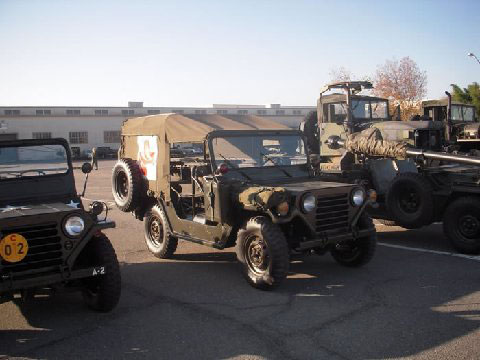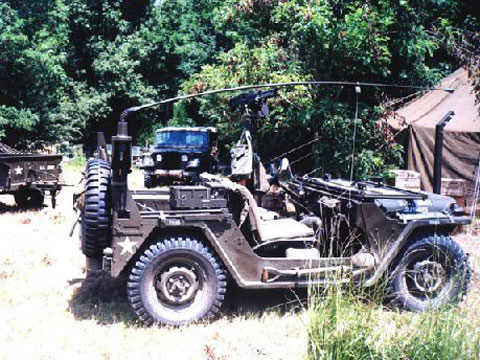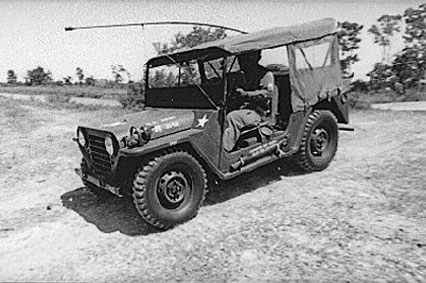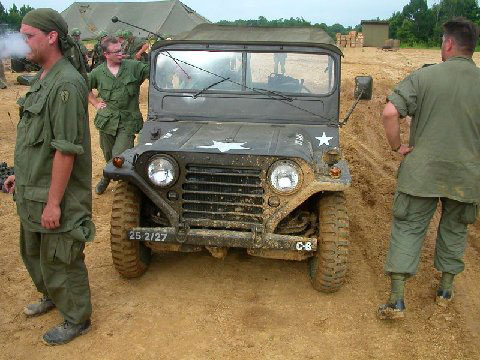
M151 Jeep
-
This original design of four-wheel independent suspension incorporated substantial performance improvements over the existing 1/4 ton vehicle military fleet of M-38's and M-38A1's. The M38 and its successor model the M38A1 (later to become the civilian model CJ), were band-aid solutions from their inception

-
Among the suggestions, and later incorporated in a test vehicle were alloy rims for the 16 inch NDTT tires and an aluminum body. The resulting type accepted vehicle consisted of a sheet steel body that proved less than desirable in relation to corrosion resistance. However, this design did keep the design within total unit weight tolerances for air transportability.

-
The reliability of the United States M151 series light tactical truck led to numerous variations and production models. In the original concept vehicle developed by the Ford Motor Company, it was suggested the engine be equipped with the ignition system sealed in a compartment incorporated within the cylinder head. Proving less reliable than anticipated, this aspect of design was dropped in the type-accepted model. Along with the general body style of curved rear wheel wells, other less apparent design changes were made where the vehicle was ultimately adopted as the M151.

-
Later designers choose to retrofit solid steel bodies addressing three principle issues. Firstly, the body could be fabricated utilizing less sophisticated tooling. While labor intensive, the design fit neatly into the aspect of third world production where jobs were needed and labor expense less a consideration. Second, the design allowed a superior body in resistance to often-harsh environments as found in many third world countries. Third, the design was such that many countries could afford a larger fleet of a proven vehicle design, and a reduced maintenance ready capability. The M-151 was clearly designed to be maintained under field operating conditions. Balanced against the high initial cost and technician training required, the M-151 based vehicle was simply more cost effective for many fleet solutions.
This particular version of the M-151 variant prototype incorporates the heavy steel construction and the updated composite lighting system. It is capable of supporting the same, and in many respects a larger variety of indirect and direct fire support weapons platforms.
It is only one of few remaining examples and continues to suggest a solution for shrinking budgets and increased government requirements of many countries.

A HISTORY OF DEVELOPMENT FOR THE U.S. M-151 JEEP
The United States military series of jeep known as the M151, came as a result of Ford Motor Company having been awarded the contract for development of replacement vehicles for the aging US military fleet of WWII and Korea. Begun in 1951, under a program known as the Military Utility Tactical Truck Project (MUTT), it became known as a most reliable vehicle suitable for multiple roles and applications.
The MUTT became standardized for American and allied countries in 1960. Over 100 foreign countries use the M151 in their existing police and military forces.
The M151 is a large departure from previous jeeps, both in looks and design. The M151 has a unitized body with a integral box frame. It is the same weight and an World War II jeep even though it is a larger vehicle. It has a longer wheelbase, is wider and is lower than the military version of the CJ-5 which was known as the M38A1.
THE HISTORY OF M-151 ROLL-OVER
During the course of its early production, the M151 gained a reputation of 'rolling over' in a certain situations. One report states, "that in fiscal 1967, the M151 was involved in 3,538 accidents that resulted in 104 deaths and 1,858 injuries."
According to the report, 36 percent of the accidents were due to the vehicle overturning in a non-collision situation. The remaining accidents were of a conventional auto crash circumstance. The principle causes identified were:
Operators not being sufficiently trained
Operator error
The primary factors that came from the 1967 study suggested three 'core' contributory issues.
The vast majority of person in the U.S.Army were young men who were drafted - not career soldiers, thus there was a 'care less' attitude.
1. Operators would make a full 90 degree turn at higher speeds than recommended
2. Viet Nam was in full swing contributing to a nonchalant attitude on the part of many young soldiers
Additional contributing factors suggested was the vehicle having been designed for OFF ROAD USE as its primary mission. The tires used by U.S. and many allied forces, are of the Non-Directional Tread (NDT) type. Simply stated this means there is no specific tread pattern - the tire is made for gripping soft soil or wet unimproved surfaces. Operators of the M151 displayed a propensity for application of civilian automobile handling characteristics in their driving habits but in fact were using a primarily off road vehicle with no tread on the tires.
An 'A' arm with a coil spring is used on each wheel. The M151 and the M151A1 have the pivots on the inside of the wheel. The M151A2 changes the rear 'A' arms to pivot front to back. This greatly reduced the tendency to roll over in a high speed turn.
CHRONOLOGY OF DEVELOPMENT
- 1950 Continental Army Command places requirement for a new's ton 4x4 with the Ordnance Corps.
- 1951 Ford Motor Company awarded the development contract for the new vehicle.
- 1952 Ford Motor Company produces the first prototype.
- 1954 Ford Motor Company produces the second prototype called the XM151.
- 1956 Ford Motor Company produces two additional prototype vehicles
+ XM151E2 - steel body
+ XM151E1 - aluminum body.
- 1959 The Ford Motor Company prototype XM151E2 chosen for production.
- 1960 The United States Military jeep, model M-151 begins production.
- 1964 Concluding the review of data collected from military units changes in the production took place resulting in a refined version of the jeep that was type accepted as the model M-151A1.
- 1970 With additional data being made available from users in the field, additional changes were undertaken resulting in the last and final model to be type accepted. This last model was known as the M-151A2.
- 1978 Production of the M-151 series jeep is halted as the new series of tactical military vehicles is adopted.
TABULATED DATA ON M-151 SERIES JEEP
GROSS VEHICLE WEIGHT
| Total of Basic Vehicle | 2,370 lb | 1.076.0 kg |
SHIPPING DIMENSIONS AND WEIGHTS
| Overall Length | 132.7 in | 337.05 cm |
| Overall Height | 71.0 in | 180.34 cm |
| Overall Width | 64.3 in | 163.32 cm |
| Shipping Weight | 2440 lb | 1107.76 kg |
| Shipping Cubage | 350 cu ft |
ENGINE
| Model | Hercules Manufacturing (Industrial Military) |
| Horsepower Rating | 65 hp @ 4000 RPM |
| Torque Rating | 128 lb-ft @1800 RPM / 172.8N.m @ 1800 RPM |
| Firing Order | 1-3-4-2 |
| Valve Arrangement | Overhead |
| Valve Clearance: | |
| Intake | 0.015 in 0.381 mm |
| Exhaust | 0.015 in 0.381 mm |
| Compression Ratio | 7.5:1 |
| Weight - Power Plant | 528 lb. 239.7 kg |
| Weight - Engine w/flywheel & acc. | 328 lb. 148.9 kg. |
CLUTCH
| Type | Single Dry Disk |
CAPACITIES
| Cooling System | 9.0 qt | 8.51 liters |
| Engine Oil: | ||
| Capacity (Less Filter) | 4 qt | 3.78 liters |
| Filter | 1 qt | 0.0946 liters |
| Air Cleaner: | ||
| Oil Bath | 2.5 pt | 1.18 liters |
| Fuel Tank | 15.8 gal | 59.8 liters |
| Differential (each) | 2 pt | 0.95 liter |
| Transmission | 5.5 pt | 2.60 liters |
FUEL SYSTEM
| Fuel Filter | In Line and In Tank (Saran) |
| Fuel Pump | Mechanical |
| Carburetor: | |
| Type Single Barrel | |
| Make Zenith (late model) Holly (early model) | |
| Choke Manual | |
COOLING SYSTEM
| Fan Type | 4 Blade | |
| Radiator: | ||
| Type | Plate, Fin and Tube | |
| Capacity | 4.0 at3.78 liters | |
| Cap Pressure | 7.0 psi. 48.27 Kpa | |
| Thermostat: | ||
| Location | Cylinder Head | |
| Opening Range | 176-183 deg. F | 80-84 deg. C |
| Fully Open | 202 deg. F | 94 deg. C |
| Pump, Water: | ||
| Type | Centrifugal | |
| Location | Front of Cylinder Block | |
| Drive Belts: | ||
| Quantity | 3 | |
| Type | "V" wedge | |
| Width | 12 mm | |
| Length | 35.25 in. 89.5 cm | |
ELECTRICAL SYSTEM
| Batteries: | |
| Type | 2 HN Military |
| Voltage | 24 Volts |
| Plates Per Cell | 11 |
| Number Used | 2 |
| Series Voltage | 24 |
| Spark Plugs: | |
| Size | 14 mm |
| Gap | 032 - .036 in. .81 - .91 mm |
| Updates | Civilian 14mm usable with sealed System W/adapter |
| Generator: | |
| Make | Delco or Prestrolite |
| Amp Rating | 60 amp - Standard |
| Model | 3002 A-A |
| Part Number | 10929868 |
| Voltage Rating | 28 volts |
| Operating Range | 800-2500 RPM |
| Type | Internal Rectification |
| Additional | Early Models were generator & 100 amp kits available |
IGNITION SYSTEM
| Standard Ignition: | |
| Distributor Make | Prestolite |
| Rotation-Rotor End | Clockwise |
| Type of Advance | Centrifugal |
| Breaker Point Opening | 0.017-0.022 in. 0.43-0.56 mm |
| Cam Angle | 39 - 46 deg. |
| Voltage | 24 Volts |
| Timing | 6 deg. BTDC |
| Ignition Coil Location | Distributor Housing |
| Solid State Ignition: | |
| Make | Prestolite |
| Rotation-Distributor End | Clockwise |
| Type of Advance | Centrifugal |
| Voltage | 24 volts |
| Rotor | Heavy-duty |
| Control Module | Breakerless Inductive Discharge |
| Trigger Wheel-Magnetic Pick-Up (Air Gap) | 0.010 in 0.25 mm |
| Solid State Ignition: | |
| Make | Swiss Control |
| Rotation of Distributor End | Clockwise |
| Type of Advance | Centrifugal |
| Voltage | 24 volts |
| Timing | 6 deg. BTDC |
| Rotor | Magnetic |
| Control Module | Breakerless Inductive Discharge - not adjustable |
TRANSMISSION
| Type | Selective Synchromesh |
| Number of Levels | 4 forward - 1 reverse |
| Road Speed & Maximum Permissible:: | |
| 1 st | 11 mph |
| 2 nd | 21 mph |
| 3 rd | 40 mph |
| 4 th | 65 mph |
TRANSFER CASE
| Type | Single Speed |
STEERING SYSTEM
| Toe-in | 1/16 - 3/16 in | 1.59 - 4.76 mm |
| Steering Wheel | 17.25 in dia | 44 cm diagonal |
PROPELLER SHAFTS
| Type of Joint | Cardan |
| Drive | Front and Rear |
SUSPENSION
| Type | Independent, four-wheel |
| Spring Type | Coil |
| Front Shock Absorbers: | |
| Quantity | 2 |
| Type | Hydraulic, telescopic |
| Action | Two-way, direct (Jounce & Rebound control) |
| Stops | Internal, hydraulic (Jounce & Rebound) |
| Rear Shock Absorbers: | |
| Quantity | 2 |
| Type | Hydraulic, telescopic |
| Action | Two-way, direct (Jounce & Rebound control) |
| Stops | Internal, hydraulic (rebound only) or mechanical internal (rebound only) |